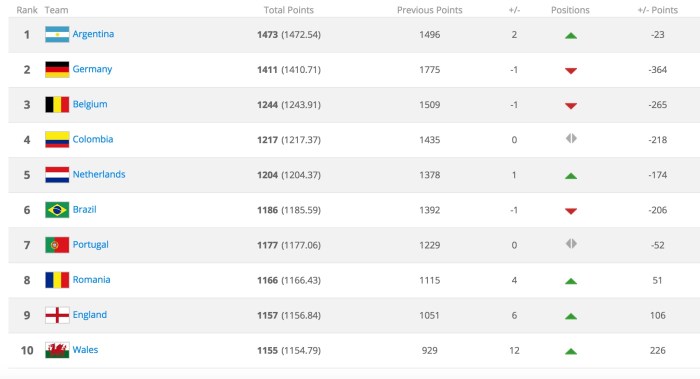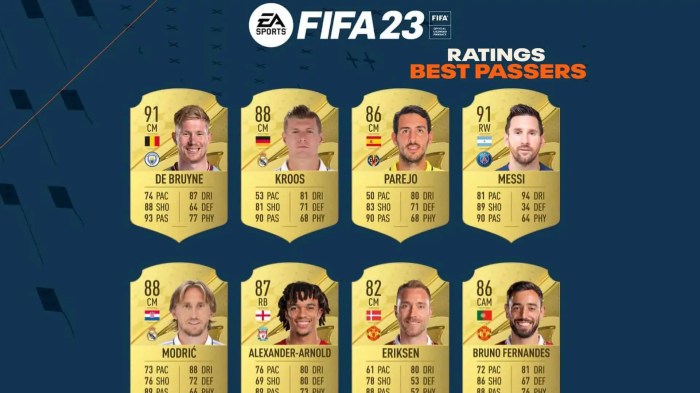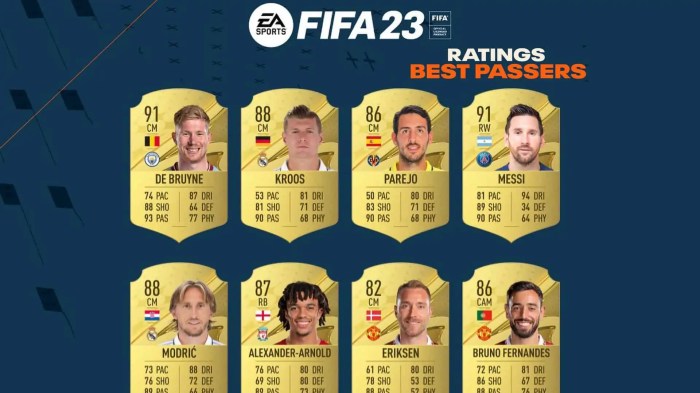Player Rankings are everywhere in online gaming, shaping how we compete, strategize, and even experience the game itself. From the familiar Elo system in chess to the more complex MMR used in MOBAs like Dota 2 and League of Legends, ranking systems fundamentally impact player interaction and motivation. This exploration delves into the various types of ranking systems, the factors influencing them, and their broader impact on the gaming world.
We’ll unpack how these systems work, their strengths and weaknesses, and the ongoing debate surrounding fairness and accuracy.
We’ll examine different ranking algorithms, exploring how they’re designed, updated, and the potential for biases. We’ll also discuss how visual representations of rankings – leaderboards, graphs, and charts – affect player perception and motivation. Ultimately, this discussion aims to provide a comprehensive understanding of the complex relationship between player rankings and the overall gaming experience.
Types of Player Rankings

So, you wanna know about player rankings? It’s way more complicated than just “best” and “worst.” Different games use different systems, each with its own strengths and weaknesses. Let’s dive into some of the most popular methods.
Elo Rating System
The Elo system is probably the most well-known ranking system. It’s based on a statistical model that calculates the probability of one player beating another. Essentially, it estimates the skill level of each player and updates these ratings after each match. A win against a higher-rated opponent results in a larger rating increase than a win against a lower-rated opponent, and vice versa.
This system is widely used because it’s relatively simple to understand and implement, and it provides a consistent way to compare players across different time periods.
Glicko Rating System
Glicko is an improvement on the Elo system. It addresses some of Elo’s shortcomings by incorporating a “rating deviation” which reflects the uncertainty in a player’s rating. This means that a player with a high rating deviation is considered less certain than a player with a low rating deviation, even if they have the same rating. This is especially useful when dealing with players who haven’t played many games.
Chess.com and Lichess are two popular online chess platforms that use Glicko or its more advanced variant, Glicko-2. The added uncertainty factor makes it more robust to short-term fluctuations in performance.
Matchmaking Rating (MMR)
MMR systems are often found in online multiplayer games. Unlike Elo and Glicko, MMR is less about providing an absolute measure of skill and more about matching players of similar skill levels for fair and competitive matches. The exact calculation methods for MMR are often proprietary and not publicly disclosed. The goal is to create balanced matches, leading to a more enjoyable gaming experience for everyone.
League of Legends and Dota 2 are prime examples of games that heavily rely on MMR for matchmaking.
Comparison of Ranking Systems
Here’s a table summarizing the key differences:
| Ranking System | Game Example | Strengths | Weaknesses |
|---|---|---|---|
| Elo | Chess (traditional and online) | Simple to understand and implement; provides a consistent measure of skill over time. | Doesn’t account for uncertainty in ratings; can be slow to adapt to changes in skill. |
| Glicko | Chess.com, Lichess | Accounts for uncertainty in ratings; adapts more quickly to changes in skill. | More complex to implement than Elo. |
| MMR | League of Legends, Dota 2 | Focuses on creating balanced matches; leads to a more enjoyable gaming experience. | Exact calculations are often proprietary; doesn’t necessarily provide an absolute measure of skill. |
Factors Influencing Player Rankings

So, you wanna climb those leaderboards, huh? Getting a high player rank in competitive games isn’t just about raw talent; it’s a complex mix of several key factors. Think of it like a recipe – you need the right ingredients in the right proportions for the perfect dish (a top-tier rank, in this case). Let’s break down those ingredients.
Player rankings are a reflection of a player’s overall performance within a game’s competitive ecosystem. Several interwoven factors contribute to a player’s final standing, making it a dynamic and constantly shifting landscape. Understanding these factors can help players improve their performance and ultimately achieve a higher rank.
Skill and Mechanical Ability
Skill is the foundation upon which all other factors are built. This encompasses a player’s dexterity, reaction time, and strategic thinking within the game. High-level players exhibit precise control, efficient resource management, and an understanding of advanced techniques. For example, in a first-person shooter, this might mean impeccable aim, quick reflexes, and knowledge of map layouts and strategic positioning.
In a strategy game, it might mean efficient resource gathering, strategic unit placement, and counter-strategy development. The higher the skill level, the more likely a player is to win matches and climb the rankings.
Experience and Game Knowledge
Experience plays a crucial role in refining skill and understanding game mechanics. The more a player plays, the better they understand the nuances of the game, including the strengths and weaknesses of different characters, items, or strategies. This knowledge allows for better decision-making and adaptation to changing circumstances during gameplay. A seasoned player can often anticipate opponent actions and exploit weaknesses more effectively than a newcomer, leading to better win rates and higher rankings.
Think of it like this: a chess grandmaster doesn’t just know the rules; they understand the subtle strategies and patterns developed over years of playing.
Luck and Randomness
Let’s be real; sometimes, luck just plays a part. Random events, such as critical hits, unexpected enemy spawns, or even lag, can significantly impact the outcome of a match. While skill and experience reduce the influence of luck, it’s impossible to eliminate it entirely. A skilled player might have a string of bad luck, leading to losses, while a less-skilled player might experience a lucky streak, boosting their rank temporarily.
This doesn’t diminish the importance of skill, but it acknowledges the inherent randomness present in many games.
Factors Influencing Player Rankings: A Prioritized List
It’s difficult to assign exact percentages to each factor, as their relative importance varies depending on the game. However, a general prioritization could look like this:
- Skill and Mechanical Ability (50-60%): This forms the core of a player’s performance. Consistent skill is the most reliable predictor of success.
- Experience and Game Knowledge (30-40%): This amplifies skill, enabling players to make better decisions and adapt to various situations.
- Luck and Randomness (10-20%): While impactful, luck is less predictable and less controllable than skill and experience.
Dynamic Player Rankings

Player rankings aren’t static monuments; they’re living, breathing reflections of performance. After every match or game, the numbers shift, reflecting the ebb and flow of competition. This dynamism is crucial for maintaining the accuracy and relevance of any ranking system, ensuring that the top players truly represent the current peak of skill. Understanding how these rankings are updated is key to grasping their true meaning.Player ranking updates hinge on algorithms designed to quantify the outcome of each contest.
These algorithms consider various factors, not just the win or loss itself, but also the margin of victory, the strength of the opponent, and even the context of the game. Different sports and games utilize different algorithms, tailored to their specific dynamics. Some algorithms are simple, while others are incredibly complex, involving intricate statistical models and machine learning techniques.
The goal, however, remains the same: to accurately reflect a player’s current skill level based on their recent performance.
Ranking Adjustment Algorithms
Many ranking systems employ variations of the Elo rating system, a method originally designed for chess but now widely adapted for various competitive scenarios. In its simplest form, the Elo system adjusts a player’s rating based on the expected outcome of a match compared to the actual outcome. If a player performs better than expected, their rating increases; if they underperform, their rating decreases.
The magnitude of the adjustment depends on the difference between the expected and actual results, and the ratings of the opponents involved. More sophisticated algorithms might incorporate factors like the home-court advantage, player form over time, and even the specific strategies employed during the game. For example, in a game like Dota 2, a player’s performance metrics (kills, assists, deaths, etc.) could be factored into the algorithm, creating a more nuanced rating system.
The key is to strike a balance between responsiveness to recent results and stability to avoid wild fluctuations.
Ranking Inflation and Deflation
Ranking inflation occurs when the average rating of players in a system increases over time, often due to an algorithm that is too sensitive to wins or a lack of sufficiently strong opponents at the top. This makes it seem like the overall skill level is improving, even if it isn’t. Conversely, ranking deflation happens when the average rating decreases, potentially caused by an algorithm that is too harsh on losses or an influx of new, lower-ranked players.
Both scenarios distort the true meaning of the rankings, making comparisons across different time periods unreliable. Maintaining a stable and accurate ranking system requires careful calibration of the algorithm to avoid these distortions. Regular reviews and adjustments are necessary to ensure the system remains robust and reflects the actual competitive landscape.
Simplified Ranking Algorithm, Player Rankings
Let’s imagine a simplified algorithm. We’ll use a basic point system. Each player starts with a base rating of 1000 points. After a match, the winner gains points, and the loser loses points. The point difference depends on the rating difference between the players.Step 1: Calculate the rating difference. Subtract the loser’s rating from the winner’s rating.
Let’s say Player A (1200) beats Player B (1000). The difference is 200.Step 2: Determine the point adjustment. A percentage of the rating difference is used to adjust the ratings. Let’s use 10%. In this case, 10% of 200 is 20 points.Step 3: Update the ratings. Player A gains 20 points (1220), and Player B loses 20 points (980). The algorithm considers the rating difference to ensure that beating a higher-rated opponent results in a larger point gain than beating a lower-rated opponent.
This simplified model lacks the sophistication of real-world ranking systems but illustrates the fundamental principles of dynamic ranking adjustments.
Impact of Player Rankings on Gameplay

Player rankings, while seemingly a simple metric, exert a profound influence on the overall gaming experience. They affect not only individual player behavior but also team dynamics and the long-term health of the game itself. Understanding this impact is crucial for game developers and players alike.Player rankings significantly shape the psychological landscape of a game.
Psychological Effects of Player Rankings on Player Behavior
High rankings often fuel a sense of accomplishment and pride, motivating players to continue improving and striving for even greater heights. Conversely, consistently low rankings can lead to frustration and discouragement, potentially causing players to abandon the game altogether. The pressure to maintain or improve ranking can also lead to increased stress and anxiety, impacting a player’s enjoyment.
For example, in competitive games likeLeague of Legends*, players experiencing a losing streak might experience tilt, a state of frustration that negatively affects their decision-making and gameplay. This is directly linked to their perceived ranking and the pressure to maintain it. Conversely, a player experiencing a winning streak might become overconfident, leading to risky plays and ultimately, a decline in performance.
The constant pressure to perform at a high level can also lead to burnout.
Influence of Player Rankings on Team Composition and Strategy
Player rankings heavily influence team composition and strategic decision-making. In team-based games, players with higher rankings are often prioritized for key roles or positions. This can lead to imbalances within teams, with highly ranked players potentially dominating gameplay and less experienced players feeling marginalized. Furthermore, team strategies might be adjusted to cater to the strengths and weaknesses of individual high-ranking players, potentially sacrificing overall team synergy for individual performance.
For instance, in a game like
Dota 2*, a team might prioritize a highly-ranked carry player, adjusting their draft and strategy to ensure that player receives the necessary resources to succeed, even if it means sacrificing early game control.
Impact of Ranking Systems on Player Engagement and Retention
Well-designed ranking systems can significantly boost player engagement and retention. A system that provides clear goals, regular feedback, and a sense of progression can keep players motivated and invested in the game. Conversely, poorly designed systems that are unfair, opaque, or overly competitive can drive players away. For example, a ranking system that is heavily reliant on luck or that does not accurately reflect player skill can lead to frustration and a decline in engagement.
Conversely, a system that rewards consistent improvement and offers opportunities for advancement can increase player retention. Games with transparent and skill-based ranking systems tend to retain players longer.
Effects of Different Ranking Systems on Overall Gaming Experience
Different ranking systems create vastly different gaming experiences. A purely competitive ranking system, such as an Elo system, might foster intense competition but could also lead to a toxic environment. A more relaxed system, such as a tiered system with less emphasis on precise numerical rankings, might create a more welcoming and inclusive atmosphere. The choice of ranking system has a profound effect on the overall tone and feel of the game.
For example, the casual nature ofOverwatch’s* competitive system, while still featuring rankings, contrasts sharply with the highly competitive and demanding ranking systems in games like
Counter-Strike
Global Offensive*. This difference influences the type of player each game attracts and the overall gaming experience they provide.
Commonly Asked Questions
What’s the difference between Elo and Glicko?
Elo is simpler, directly comparing players based on win/loss. Glicko is more sophisticated, accounting for the uncertainty in player skill and incorporating a rating deviation.
How often are rankings updated?
It varies widely depending on the game. Some update after every match, others might use a batch system or update less frequently.
Can rankings be manipulated?
While difficult in well-designed systems, manipulation is possible through collusion or exploiting system flaws. Robust systems incorporate safeguards to minimize this.
What about smurfing (creating new accounts to play at lower ranks)?
Smurfing undermines the integrity of the ranking system and is generally against the terms of service of most games. Anti-smurfing measures are often implemented.
